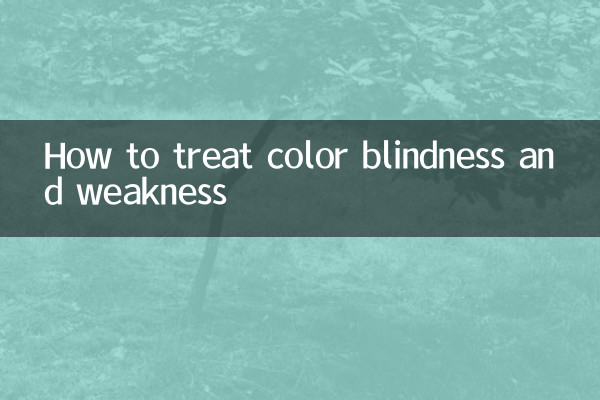How to treat color blindness and weakness
Color blindness and weak color are common visual impairments that affect the daily lives of hundreds of millions of people around the world. In recent years, with the advancement of medical technology, treatment and correction methods for color blindness and weak color have also become hot topics. This article will combine the hot content of the entire network for the past 10 days to introduce you in detail the treatment methods for color blindness and weak color, and provide structured data for better understanding.
1. The basic concept of color blindness and weak color

Color Blindness and Color Vision Deficiency are the ability to not distinguish certain colors or ranges of colors normally. Color blindness is usually caused by genetic factors, while color weakness may be caused by congenital or acquired factors. Here are the common types of color blindness:
| type | describe | Percentage |
|---|---|---|
| Red and green blind | Can't distinguish between red and green | About 75% of patients with color blindness |
| Blue and yellow blind | Can't distinguish between blue and yellow | About 20% of patients with color blindness |
| Total color blindness | Can't distinguish any color | About 5% of patients with color blindness |
2. Treatment methods for weak color blindness
Currently, there is no complete cure for color blindness and weak color, but the visual experience of patients can be improved by:
| Treatment method | Applicable groups | Effect |
|---|---|---|
| Color blindness correction glasses | Patients with red and green blindness | Significantly improve color discrimination ability |
| Color blindness correction contact lenses | Patients with mild color weakness | Partially improve color perception |
| Gene therapy (experimental stage) | Patients with congenital color blindness | Still under research and not popular |
| Visual training | Patients with weak color | Slightly improve color recognition |
3. Principles and effects of color blindness correction glasses
Color blindness correction glasses are one of the most popular color blindness treatment tools at present. The principle is to filter out light at a specific wavelength through special filters, thereby enhancing color contrast. The following is a comparison of recent popular brands and their effects:
| brand | Price range | Applicable Type | User rating (5-point scale) |
|---|---|---|---|
| EnChroma | 2000-4000 yuan | Red and green blind | 4.5 |
| Pilestone | RMB 1000-2500 | Red, green/blue and yellow blind | 4.2 |
| Colorlite | 1500-3000 yuan | Patients with weak color | 4.0 |
4. Latest progress in gene therapy
Gene therapy has been a hot research direction in the field of color blindness treatment in recent years. Scientists try to repair gene defects that cause color blindness through gene editing techniques such as CRISPR. The following are recent research progress:
| Research Institutions | Research objects | Current stage | Estimated clinical application time |
|---|---|---|---|
| Harvard Medical School | Red and green blind | Animal experiments | 2025-2030 |
| University of Cambridge | Blue and yellow blind | Cell experiments | After 2030 |
5. Daily life assistance tools
For patients who are temporarily unable to receive treatment, the following auxiliary tools can help improve quality of life:
| Tool Type | Function | Recommended products |
|---|---|---|
| Mobile app | Color recognition | Color Blind Pal |
| Computer software | Screen color adjustment | f.lux |
| Special mark | Item color marking | Colorino |
6. Prevention and precautions
Although congenital color blindness cannot be prevented, acquired color weakness can reduce the risk by:
1. Avoid long-term exposure to strong light
2. Regular vision check
3. Avoid exposure to toxic chemicals
4. Maintain a healthy lifestyle
Summarize
Although color blindness and color weakness cannot be completely cured at present, with the development of technology, treatment methods are constantly improving. From corrective glasses to gene therapy, there are more and more patients' choices. It is recommended that patients with weak color blindness choose appropriate treatment methods based on their own conditions and make full use of auxiliary tools to improve their quality of life.

check the details

check the details